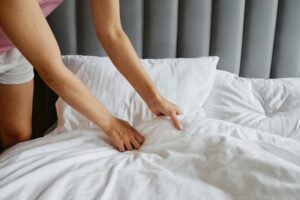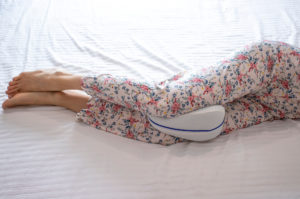How to Wash Down and Feather Pillows
Down and feather pillows are known for their luxurious feel. The key to keeping them that way is gentle handling throughout the washing process. This applies to machine- and hand-washing. Your goal is to preserve the soft, fluffy texture of the feathers without damaging them.
For the best results, refer to the manufacturer’s care instructions on the label. To give you a general understanding of the process, we’ll share some standard guidelines on washing down and feather pillows in a machine or by hand.
The Difference Between Down and Feather Pillows
While down and feather pillows may feel similar at first, they’re made from different materials—and understanding the difference can help you care for them properly.
- Down pillows are filled with the soft, fluffy clusters found beneath the outer feathers of ducks or geese, typically around the chest area. Down is lightweight, highly insulating, and provides a plush, cloud-like feel. Because it lacks quills, down is also less likely to poke through the fabric or cause irritation.
- Feather pillows, on the other hand, are filled with the outer feathers of the bird, which include quills. These pillows tend to be firmer, heavier, and more structured than down pillows. While they still offer softness, they’re generally more supportive and can flatten out over time, requiring regular fluffing.
Many pillows on the market use a blend of down and feathers, combining the loft and softness of down with the structure and affordability of feathers.
How to Wash Down and Feather Pillows
Machine-Wash
Because feathers and down are delicate materials, you should take special care when washing pillows with this fill. Always check the manufacturer’s care instructions, which specify the proper washing method and temperature.
- Remove your pillowcase, and inspect the pillow for rips.
- Wash two pillows at the same time to balance out the machine.
- If using a top-load washer with an agitator, load pillows vertically to reduce the risk of damage.
- Use a mild detergent or a low-sudsing detergent specifically for feathers and down.
- Use a small amount of detergent to avoid soap residue and clumping.
- Use the cool or warm water settings since hot water can damage down.
- Always choose the delicate setting to avoid damaging the fill.
- Add an extra rinse and spin cycle to remove soap residue and excess water.
Hand-Wash
If you don’t feel comfortable putting your down or feather pillows in a machine, you can also wash them by hand. The process is very similar to using a washing machine but with a bit more labor on your part. Before you begin, review the manufacturer’s care instructions for the appropriate water temperature.
- Remove the pillowcase, and inspect the pillow and its seams for tears.
- Fill a tub with cool or warm water per the care instructions.
- Add a small amount of mild detergent to the water, and stir until well mixed.
- Place the pillow in the water, and get it completely wet.
- Gently squeeze the pillow to remove dirt and stains.
- Repeat, moving the pillow back and forth in the water and squeezing gently.
- Remove the pillow from the dirty water, and rinse it in clean water until the water runs clear.
- Remove the excess water by gently squeezing the pillow with your hands or pressing it between two towels. Do not wring your pillow because it could damage the down or feathers.
How to Dry Down and Feather Pillows
Machine-Dry
Once your pillows are fresh and clean, it’s time to dry them. Again, refer to the manufacturer’s care instructions for the best results. Many pillows can be machine-dried.
- Remove excess water from the pillows by gently squeezing or pressing them between two towels. Do not wring the pillows because it can damage the fill.
- Use the delicate setting on low heat or no heat for several cycles.
- Fluff the pillows in between cycles or use dryer balls to break up any clumps.
- Carefully check for any odor or clumps that could indicate lingering moisture. Mold may grow if the pillow isn’t completely dry, so run more dryer cycles or hang the pillow on a clothesline to finish air-drying if necessary.
Air-Dry
Air drying a down pillow takes time and patience, but it’s a gentle way to preserve the pillow’s shape and loft without exposing it to the heat of a dryer.
- After washing, press the pillow between clean, dry towels to remove as much moisture as possible—don’t wring or twist, as this can damage the down clusters.
- Place the pillow on a drying rack or a clean, breathable surface in a well-ventilated area. Avoid direct sunlight, which can cause the fabric to fade or weaken.
- Every few hours, turn and gently fluff the pillow to help it dry evenly and restore its loft. This also helps prevent clumping and mildew from forming.
- Speed up the drying process by placing the pillow near a fan or open window to improve airflow. Dehumidifiers can also help if you’re drying indoors in a humid environment.
- Air drying can take 24 to 48 hours. Make sure the pillow is completely dry before using or storing it—any lingering moisture can lead to mold or mildew.
Why It’s Important to Keep Pillows Clean
Keeping your pillow clean can enhance your comfort, reduce odors and allergens, and maintain a more hygienic sleep environment. The process involves more than simply washing the pillowcase, especially if you have a feather or down pillow. Over time, the pillow flattens, and proper washing restores the down’s fluffy texture. By drying the pillow correctly, you can also prevent the unpleasant smell of damp feathers and reduce the risk of mold.
Washing pillows may seem burdensome, but there are legitimate health reasons to do so. Several substances can build up in the pillow, some of which may cause allergic reactions.
- Sweat
- Drool
- Oils
- Skin and hair products
- Dead skin cells
- Dust mites (and their droppings)
Even though they may not be visible, skin cells fall off and collect on your pillow. Dust mites are attracted to them. Though mostly harmless themselves, dust mites leave behind droppings that can cause allergy symptoms, like itchy eyes, runny nose, and sneezing . They can also result in asthma symptoms, like coughing, wheezing, and difficulty breathing.
Bodily fluids, such as sweat, drool, and natural oils, can also soak through the pillowcase to your pillow. Sweat, in particular, leaves behind a telltale yellow spot. Additionally, skin and hair products may contain oils and chemicals that could stain the pillow.
How Often to Wash Your Pillows
Depending on their materials and your lifestyle, you should generally aim to wash your pillows at least every six months. You may need to wash them more often if you sweat at night, have regular allergy symptoms, or use heavy face and hair products.
It’s easy to assume that a clean pillowcase equals a clean pillow. However, even if you wash your pillowcases every two weeks as recommended, your pillow still needs to be cleaned as well.
When it comes to feather and down pillows, proper washing can actually help restore the feathers and down to a plush, fluffy state. In contrast, inexpensive synthetic pillow fill sometimes clumps after washing.
How to Make Your Pillows Last Longer
With the right care, down and feather pillows can offer years of comfort and support. Here are some simple ways to extend their lifespan:
- Use a pillow protector: A zippered pillow protector acts as a barrier against sweat, body oils, dust mites, and spills—all of which can degrade the feather filling over time. Wash the protector regularly along with your pillowcase.
- Fluff daily: Give your pillow a quick fluff each morning to help maintain its shape and evenly redistribute the fill. This keeps it feeling full and helps prevent clumping or flattening.
- Spot clean as needed: Address stains or spills right away using a mild detergent and a clean cloth. Avoid soaking the pillow unless it needs a full wash.
- Wash sparingly and carefully: Wash your pillow only a few times a year or as needed, following care instructions closely. Overwashing can break down the fill and shorten its lifespan.
- Air it out: Let your pillow air out in a sunny, dry spot every few weeks to keep it fresh and reduce moisture buildup.
- Replace when necessary: Even well-maintained pillows eventually wear out. If your pillow feels flat, lumpy, or doesn’t bounce back after fluffing, it may be time for a replacement—usually every one to three years for feather and down pillows.
Find a Pillow That’s Right for You
Looking for a new pillow? Take the quiz below to find the perfect pillow for your needs.
Trouble sleeping?
Answer these 5 easy questions to discover your perfect pillow

Trouble sleeping?
Answer these 5 easy questions to discover your perfect pillow
What position do you sleep in?

Side

Back

Stomach
Frequently Asked Questions
How do you freshen feather pillows without washing them?
To freshen a feather pillow without washing it, hang it outside on a dry, breezy day to air it out and remove odors. You can also place it in the dryer on a no-heat or low-heat setting for 10 to 15 minutes with a couple of clean tennis balls or dryer balls to fluff it up and release trapped moisture. Lightly sprinkling baking soda on the pillow and letting it sit for 30 minutes before vacuuming it off can also help neutralize odors.
Why do feather pillows smell after washing?
Feather pillows may smell after washing because the feathers are slow to dry and can retain moisture, leading to a musty or “wet dog” odor. This smell is typically caused by natural oils in the feathers reacting to water. Ensuring the pillow is fully dry—especially deep inside—can prevent this. If the odor persists, try running the pillow through additional drying cycles or air-drying in the sun to help eliminate the smell.
How long should you keep a down pillow?
A well-cared-for down pillow can last anywhere from five to 10 years, depending on the quality and how often it’s used. You should replace it if it becomes flat, lumpy, or no longer provides adequate support, even with regular fluffing. To test its longevity, fold the pillow in half and let go. If it doesn’t spring back into shape, it’s likely time for a new one.

Still have questions? Ask our community!
Join our Sleep Care Community — a trusted hub of sleep health professionals, product specialists, and people just like you. Whether you need expert sleep advice for your insomnia or you’re searching for the perfect mattress, we’ve got you covered. Get personalized guidance from the experts who know sleep best.
References
1 Sources
-
InformedHealth.org [Internet]. Cologne, Germany: Institute for Quality and Efficiency in Health Care (IQWiG); 2006-. Overview: Dust mite allergies. [Updated 2023 Aug 17]. Available from: https://www.ncbi.nlm.nih.gov/books/NBK447098/
https://www.ncbi.nlm.nih.gov/books/NBK447098/




























